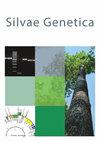Genotype by environment interaction and teak (Tectona grandis L.) selection in Costa Rica
IF 1
4区 农林科学
Q3 FORESTRY
引用次数: 6
Abstract
Abstract A teak progeny trial was established with four replicates at different sites along the northern Pacific region of Costa Rica. The trials followed a randomized block design, with 28 open pollinated families and 36 seedlings per family per site. Data from 7 years-old trees was analyzed both for each test location separately and for all locations combined. High individual heritability was found for diameter, which translates to higher breeding potential. The all locations combined analysis showed high genetic variation, with individual heritabilities reaching up to 22 %. Genotype by Environment (GxE) interactions explained only 2.5 % of total phenotypic variation. The genetic correlation (rg) among all four sites was 0.69. Hence, it is concluded that GxE interactions are not problematic for breeding purposes since they are not complex in nature. This teak breeding population showed strong genetic stability and performed well in most environments in the study area. The Hojancha location showed high genetic correlation with all other sites; therefore, it should be chosen for future testing and selection of elite genotypes. Selection of the 20 best individuals, allowing for up to two individuals per family, would result in a 1.78 cm (11 %) gain in diameter. Furthermore, based on this selection the inbreeding coefficient (F) in the offspring would only reach 2.9 %, while the expected effective population size (Ne) would be16.97 individuals. This selection scheme could reduce rotation age by almost two years, since the diameter goal of 40 cm would be reached earlier than the usual 20 years cycle. The results suggest that the progeny trial can be maintained as a single breeding population, suitable for planting in any site along the Northern Pacific region of Costa Rica.哥斯达黎加柚木(Tectona grandis L.)的环境互作和基因型选择
摘要在哥斯达黎加北太平洋地区不同地点建立了柚木子代试验,共4个重复。试验采用随机区组设计,28个开放授粉家庭,每个家庭每个地点36棵幼苗。来自7年树龄树的数据分别对每个测试地点和所有地点进行了分析。直径的个体遗传率高,具有较高的育种潜力。所有地点的综合分析显示出较高的遗传变异,个体遗传率高达22%。环境基因型(GxE)相互作用仅解释了总表型变异的2.5%。4个位点的遗传相关(rg)均为0.69。因此,可以得出结论,GxE相互作用对育种目的没有问题,因为它们本质上并不复杂。该柚木育种群体遗传稳定性强,在研究区大部分环境中表现良好。Hojancha位点与其他所有位点具有较高的遗传相关性;因此,在未来的检测和精英基因型的选择中应该选择它。选择20个最好的个体,允许每个家庭最多两个个体,将导致直径增加1.78厘米(11%)。在此选择基础上,子代近交系数F仅为2.9%,预期有效种群大小Ne为16.97个。由于40 cm的直径目标比通常的20年周期要早,因此该选择方案可以使轮作年龄减少近两年。结果表明,后代试验可以维持为一个单一的繁殖种群,适合在哥斯达黎加北太平洋地区的任何地点种植。
本文章由计算机程序翻译,如有差异,请以英文原文为准。
求助全文
约1分钟内获得全文
求助全文
来源期刊

Silvae Genetica
农林科学-林学
CiteScore
2.20
自引率
10.00%
发文量
10
审稿时长
3 months
期刊介绍:
Silvae Genetica is an international peer reviewed journal with more than 65 year tradition and experience in all fields of theoretical and applied Forest Genetics and Tree breeding. It continues "Zeitschrift für Forstgenetik und Forstpflanzenzüchtung" (Journal of Forest Genetics and Forest Tree Breeding) founded by W. LANGNER in 1951.
 求助内容:
求助内容: 应助结果提醒方式:
应助结果提醒方式:


